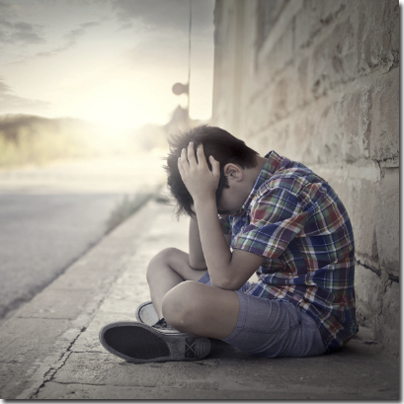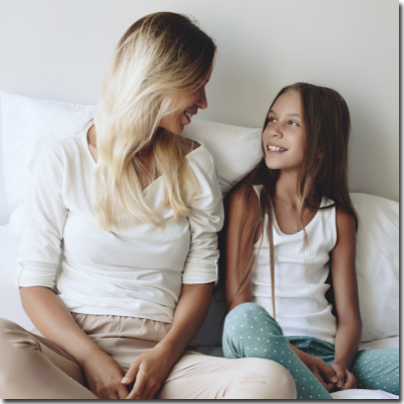 Our children all have days when their whole world seems to be falling apart. Is the universe really going up in smoke? Probably not, but our children may need a lot of help to see that.
Our children all have days when their whole world seems to be falling apart. Is the universe really going up in smoke? Probably not, but our children may need a lot of help to see that.
When my daughter was in kindergarten, she suddenly began to make negative comments about herself and her abilities. She would often say, “I’m not good at coloring” and “sports are hard for me,” indicating that she had low self-esteem.
The overwhelming transition into the world of elementary school left her struggling to make friends and made her quick to compare her abilities to those of her peers. I noticed she would make comments about how other students performed on tasks as compared to herself, and as time moved on, these comments spiraled into negative self-talk.
At a young age, she was already feeling insecure. This saddened me but I was eager to do everything I could to help her. I knew that her skills were not inadequate, yet her brain was tricking her with suggestions of inferiority and inadequacy. To my daughter, it felt like her inferiority was very real!
What is negative self-talk and why does it happen? We ALL experience self-talk or the inner monologue of that internal voice that tells us to eat the cookie or to go out for a run. Self-talk is most often constructive to our well-being and can be a positive way to process what is happening around us and to guide us through a task.
At times, however, self-talk can become critical. While intermittent critical self-talk is not necessarily cause for concern, when we observe our children engage in frequent negative self-talk we may feel some worry creep in.
Negative thinking patterns in children usually fall into a few distinct categories or patterns of talk. These include:
- Magnifying: Also called catastrophizing, this is when a child expects a small event to spiral into a large one. “I have a stuffy nose; do I have COVID?” “Am I going to die?”
- Thinking in Extremes: Sometimes called polarised thinking, this is characterized by seeing outcomes in black and white. “If I don’t win the chess match, it means I’m a bad chess player.”
- Diminishment: This is when a child waters down their successes to focus on the negative. “I only scored the goal because she let me.”
- Mind reading: When a child believes they know what the other person is thinking. “She didn’t buy me a present because she doesn’t love me.”
- “Should” statements: This is when a child sets irrational self-standards. “I should have seen this coming.”
So why does negative self-talk occur in our children? There are several potential underlying reasons for negative self-talk:
- Globalized thinking: “All or none” thinking is not uncommon in children, but consistently taking one small performance failure as a sign of an overall inadequacy can be dangerous to the self-esteem of a child.
- Perfectionism: Children who tend to set high standards for themselves are more likely to engage in negative self-talk when they fall short of those expectations.
- Social protection: For children who are very concerned about “fitting in,” believing that certain strengths are not “cool” to have, negative self-talk may be an attempt to fit in with peers.
- Attention-seeking: Negative self-talk may be an attempt to gain sympathy or attention from adults.
- Lack of resilience: Children who tend to give up quickly when something is hard may lack grit and perseverance. This can go hand-in-hand with negative self-talk statements that are out of proportion to the situation.
- Bullying: When a child is bullied frequently, external insults from peers can lead to internal self-talk.
 We all have times when we experience negative self-talk; however, when we observe our child’s negative self-talk to be excessive, it may be a cause for concern. Negative self-talk statements may be a bigger problem if we observe that they:
We all have times when we experience negative self-talk; however, when we observe our child’s negative self-talk to be excessive, it may be a cause for concern. Negative self-talk statements may be a bigger problem if we observe that they:
- continue for longer chunks of time.
- are accompanied by a negative change in our child’s sleeping/eating patterns or general health
- affect our child’s relationships and schoolwork.
Negative self-talk that holds any of these characteristics should not be ignored! If not addressed, the perils of negative self-talk can be damaging to a child’s healthy development, including the following:
- Lack of confidence: When a child constantly sees themselves though a negative lens, long-term confidence can take a huge hit.
- Loneliness: When negative self-talk becomes the default, your child may begin to push people away because they feel there is no one who understands them.
- Boredom: A child who engages frequently in negative self-talk will likely learn to “play it safe” in order to avoid failure. While this may temporarily help with some anxiety, never taking risks eventually becomes boring and unexciting.
- Fear & Depression: Living in fear of failure is paralyzing and can be a catalyst for depression.
Sounds a bit scary, right? The good news is that there are strategies that can help your child gain confidence and increase positive self-talk! Read on to see how to stop negative self-talk in your child.
#1: Validate Their Feelings
 Did you know that one in every five children suffers from an anxiety disorder? That can seem like a scary statistic! The good news is that parents can model and influence how a child deals with big emotions, such as anxiety.
Did you know that one in every five children suffers from an anxiety disorder? That can seem like a scary statistic! The good news is that parents can model and influence how a child deals with big emotions, such as anxiety.
In their book, “Anxious Kids Anxious Parents,” Reid Wilson and Lynn Lyons unearth anxiety-magnifying habits that include reassurance, avoidance, and bad problem-solving. It can be difficult to see our children suffer and it’s easy, in our attempt to ease their pain, to get into a habit that accidentally reinforces a child’s worries. Instead, Wilson & Lyons encourage parents to allow space for discomfort and validation of emotions.
 Do you sometimes feel lost in how to help your child with their worries and anxieties? We partnered with Lynn Lyons, licensed clinical social worker, psychotherapist, author, and anxiety expert, to better understand how we can coach our children to develop internal reassurance and conquer their worries, even when we aren’t around.
Do you sometimes feel lost in how to help your child with their worries and anxieties? We partnered with Lynn Lyons, licensed clinical social worker, psychotherapist, author, and anxiety expert, to better understand how we can coach our children to develop internal reassurance and conquer their worries, even when we aren’t around.
This packed masterclass is one of the 60+ masterclasses you get when you join the AFineParent Academy today. Click here to learn more.
When my daughter was younger, she had many bad days filled with crying outbursts. I would often try to shift her attention to a toy or cartoons as a temporary solution. Over time, the crying turned into negative self-talk, as she would continuously utter statements like, “I’m stupid,” or “I’m not a good person.”
It was then that I realized ignoring the problem was also not allowing my daughter to learn coping skills. Instead, I started to sit with her while she experienced big emotions; taking time to listen, understand, and validate her feelings. Most times it was because she wanted things to be perfect and got frustrated when they weren’t.
We are still working on the unrealistic desire for perfection by separating our self-worth from the problem to evaluate things with clarity. As we do this, we have turned the focus from distracting from the emotion and instead, recognizing and validating it.
 Still, trying to figure out how to best validate your child’s big emotions? Try this:
Still, trying to figure out how to best validate your child’s big emotions? Try this:
- First, listen to your child–really listen! Choose to not interrupt, get down to eye level with them, and put away phones or devices. Be present!
- Second, restate what you believe they are saying. If you have it correct, your child will likely nod or continue to share as they feel it’s safe to keep talking. If you don’t have it right, it gives your child the chance to give you more information.
- Finally, be curious and ask questions about factors that contributed to the feeling. This not only lends itself to your better understanding but communicates to your child that their emotions are important!
#2: Emphasize The Power of Yet
 When things go wrong, we all tend to feel like we are under a dark cloud of sadness. Helping our children look at the positive side of things can assist in changing their mindset. This kind of positive feedback can include praise and verbal affirmation of their strengths.
When things go wrong, we all tend to feel like we are under a dark cloud of sadness. Helping our children look at the positive side of things can assist in changing their mindset. This kind of positive feedback can include praise and verbal affirmation of their strengths.
This doesn’t mean we fill them with empty praises; doing this too often will only decrease the value of the praise. We also want to be careful not to wait until things go wrong to shower our children with praise. Instead, giving our children practical examples of how far they have come in working towards a goal can assist in changing their thinking from a “never” to a “not yet” mindset.
I’ve noticed that my daughter appreciates it when I acknowledge her progress in different areas of her life like in her grades and being responsible around the house. As I walk past her room and realize she has cleaned it, I may call her by her name, hug her, and say, “ I am so proud of you!” Her joy in hearing those words is always evident in her glowing smile and noticeable effort to continue to keep her room clean afterward.
I’ve decided to make this a regular practice instead of waiting to use it as a solution when she needs encouragement. More constant feedback has boosted her self-confidence and reduced the incidents of negative self-talk.
Whenever my daughter feels discouraged about something going wrong, I will gently prompt a conversation about how failure isn’t permanent. In addition to actively listening to her, we will discuss past situations in which failures have been lessons that she has learned from. Reminding her of concrete examples from her own life is more successfully generalized to the present situation than simply attempting to convince her that she will eventually get there. This then helps her avoid negative thoughts and talk.
When we teach our children to have a more positive perspective about themselves by emphasizing the “power of yet,” we equip them with the skills to be more confident about themselves.
We can emphasize the power of yet by:
- Being a good example. Our kids learn more from what they watch us do than what they hear us say. We can show them what perseverance looks like and remain hopeful even when things are hard.
- Reinforcing the principle with them. Whenever our child says, “I can’t do this!” we can jump in and add “yet!” Repetition can result in muscle memory of the brain, eventually adding the importance of “yet” to disappointment in the future.
- Welcoming news of failure with positivity. This may sound impossible, but when there is a failure, we can normalize it by saying things like, “well-tried,” “ keep trying,” or “you will get better if you keep practicing.” Bonus points for saying it with a big, genuine smile on your face.
- Responding to your child and yourself with grace. Growth is a process that takes time and patience!
#3: Be a Good Example
 Actions will always speak louder than words and what our children see us doing will encourage them to act accordingly. This can be HARD, especially for those of us who tend to be tough on ourselves & get caught up in negative self-talk ourselves. As a baker, I know that I’ve failed in this area when I show that I’m disappointed in myself when my cakes don’t come out the way I would like.
Actions will always speak louder than words and what our children see us doing will encourage them to act accordingly. This can be HARD, especially for those of us who tend to be tough on ourselves & get caught up in negative self-talk ourselves. As a baker, I know that I’ve failed in this area when I show that I’m disappointed in myself when my cakes don’t come out the way I would like.
Whether we all realize it or not, our actions are rubbing off on our children. When positively handling disappointment does not come easy to us, we may have to be more purposeful in creating a plan and following through on it. I’m learning that when a cake is not turning out how I want it to, it’s best to take a break from my work and resume later. Making this plan ahead of time has made it easier to fall back on in the moment.
Apart from solving our problems calmly, we can also model goal-setting and perseverance in achieving those goals. Our children must see our excitement when we achieve a goal. I’ve made it a habit to celebrate all my successes with my daughter—like when I make a beautiful cake—as this will encourage her to also go after her dreams.
Being a good model can be difficult at times; but we have plenty of opportunities as making mistakes comes with the territory of being human! Some ideas for how to be a good model include:
- Working together with our children to recognize and write down goals for the month or year and posting them somewhere in the house. Having a visual will allow the family to remind themselves and each other of the goals they are each working towards!
- Trying out purposeful positive self-talk throughout the day by committing to verbalizing three positive self-talk statements each day, making sure to say these out loud with our children within earshot!.
- Permitting ourselves to laugh with our kids as often as we can!
#4: Don’t Be Afraid to Talk About It
 In his book, Hardwiring Happiness, Rick Hanson gives the illustration of how our minds are gardens that we need to work on similarly to “pulling weeds and growing flowers.”
In his book, Hardwiring Happiness, Rick Hanson gives the illustration of how our minds are gardens that we need to work on similarly to “pulling weeds and growing flowers.”
This illustration has been very helpful in showing me how I need to help my daughter in a world where friends, social media, movies, and TV shows influence her thoughts. For us to pull the weeds, we first need to notice the weeds in the same way that I need to make an intentional effort to notice how my daughter feels about herself.
When we notice hints of negative self-talk, we can more quickly make the effort to get to the root of it (in the same way in which a weed cannot be extracted permanently unless the root is also torn up). Our kids often need guidance to separate what is true from what is false about their identity, because the world does a lot to diminish our self-worth from a young age. Talking to our kids about self-talk and self-worth may help them get a better understanding of their identity and feelings.
 We should not undermine the ability of our children to have meaningful and productive conversations about negative self-talk and how it can be harmful. Being frank and candid can often take the scariness out of the idea that they may not succeed at something. It’s important to have these conversations when our children are calm and relaxed, and may be beneficial to focus on these tips:
We should not undermine the ability of our children to have meaningful and productive conversations about negative self-talk and how it can be harmful. Being frank and candid can often take the scariness out of the idea that they may not succeed at something. It’s important to have these conversations when our children are calm and relaxed, and may be beneficial to focus on these tips:
- Discuss the effects of both positive and negative self-talk and show them how the latter can have lasting effects on their self-esteem. Just as Hanson says:
“Positive emotions encourage the pursuit of opportunities, create positive cycles, and promote success. They also strengthen your immune system, protect your heart, and foster a healthier and longer life.”
- Give examples of times when our child has felt both happy and sad, to reveal the fleeting nature of feelings. This helps to demonstrate that no feeling is permanent and therefore only something we need to work through, rather than something we need to endure endlessly.
We can also encourage such positive emotions in our children by having conversations with them about their short-term and long-term goals. Once our child has identified goals, we can help them break down the steps that will need to happen for them to reach those goals. Guiding their thought process to be more goal-oriented allows for direction and self-confidence; and gives us frequent opportunities to demonstrate the link between positive self-talk and progress towards goals.
Don’t forget how much visual support can be helpful to our children! This could mean working together to write down, draw pictures, or print out representations of goals so that they can be posted somewhere in the house as a visual reminder.
#5: Make Home a Safe Zone
 Defining a home as a “safe zone” does not only pertain to a home without physical abuse or neglect, where basic needs such as food, clothing, and shelter are met. Home should be a place where children can share their thoughts without fearing judgment or reprimand. When kids learn that sharing their thoughts often leads to reprimand, they learn not to do so at all. This doesn’t mean that the negative thoughts and feelings disappear; instead, they may take the form of defiance or disrespect.
Defining a home as a “safe zone” does not only pertain to a home without physical abuse or neglect, where basic needs such as food, clothing, and shelter are met. Home should be a place where children can share their thoughts without fearing judgment or reprimand. When kids learn that sharing their thoughts often leads to reprimand, they learn not to do so at all. This doesn’t mean that the negative thoughts and feelings disappear; instead, they may take the form of defiance or disrespect.
As children learn to be open about their thoughts and feelings, the likelihood that they will speak negatively to themselves lessens. Verbalizing thoughts can bring clarity to what is true and what is not, thus making them more conscious of how the mind can trick us!
Giving our children the knowledge that they will be listened to and validated can provide a level of comfort to a child that is necessary for breaking out of negative self-talk. I know my daughter lights up almost every time she’s speaking to me. I’ve realized that this is because I’m learning to be very accommodating of her feelings which makes her feel valued and safe.
Creating a safe zone for our children may mean:
- Teaching children to listen to and validate each other’s thoughts and feelings. All feelings and opinions should be equally important!
- Having a standard to treat others with respect. This includes respecting each other’s space, belongings, or even in the way you speak to each other (avoiding sarcasm or negative tone of voice).
- Talking about failures and learning from them as a family.
- Modeling how apologies can be given with sincerity when someone else’s feelings are hurt. While it can backfire to require children to apologize when an adult feels the need for them to, modeling how we can apologize with authenticity can be hugely impactful in encouraging our children to do this independent of a request.
- Avoiding the use of punishment for negative self-talk.
- Avoiding the use of dismissal statements and shaming. These may include statements like, “You’ll be fine” or “Don’t take everything so seriously;” dismissal statements may inadvertently give a child the impression it is wrong to feel certain emotions. Similarly, shaming statements, such as “you are a bad kid” or “you can’t do anything right” can be equally harmful, as they feed into negative esteem.
My research on how to stop negative self-talk and my journey with helping my daughter break out of it has not been smooth. I still have times when I don’t know what to do. I continue to make the decision daily to be the best parent I can be by seeking advice, reading books, and personal reflection. There is no one-size-fits-all answer to help children break free from negative self-talk. But remember, you already have the best tool in the toolbox, simply because you are their parent!
The 2-Minute Action Plan for Fine Parents
As we have all realized, helping your child break out of negative self-talk is not easy. To start your journey, take a few minutes to reflect on these questions.
- How often does my child make negative self-talk comments?
- What type of negative self-talk do I most often observe from my child? (scroll back up to the beginning of the article if you need a reminder of the different types of negative self-talk!)
- How do I respond when my child makes negative self-talk comments?
- What is the current climate in my household about negative self-talk comments? Am I open and willing to discuss them or do I tend to push them under the rug?
- How do I model my own self-talk statements?
The Ongoing Action Plan for Fine Parents
If the short self-assessment above leads you to believe that your child’s negative self-talk statements are cause for concern, then it’s time to make a plan! Pick at least two of the strategies we talked about for helping your child break out of negative self-talk and make the personal commitment to follow through with them consistently for at least two months. To get started, journal the following:
- Identify habits that you have had for a while that are hindering your growth as a positive parent and your self-talk statements. Decide on replacement statements that you can commit to saying at times when you would normally turn to negative self-talk (think about the “power of yet” and rephrasing “I can’t” statements to “I can’t yet” phrases).
- Write down the two strategies that you want to commit to. Involve spouses, significant others, co-parents, grandparents, or anyone else that may be able to help you stick with your commitment.
Every two weeks of consistently following through with your commitment to change, take a few minutes to journal the small changes you may see in your child’s self-esteem and negative self-talk statements. Celebrate even the smallest of changes that you see as you help your child break out of negative self-talk!
Thank you so much for the feedback.
Thank you Stacey for your giving heart.
You’re most welcome!
A thorough article, with practical advice. Thank you!
Your feedback is greatly appreciated, much thanks!
Very helpful article.
Thank you.
Well researched, well organized, and beautifully written. Thank you for the helpful article
Thank you so much, I appreciate the feedback.